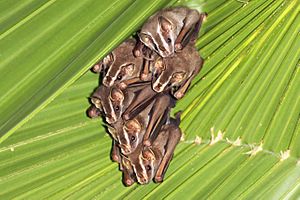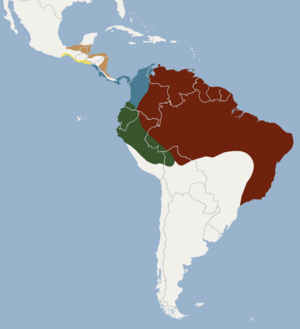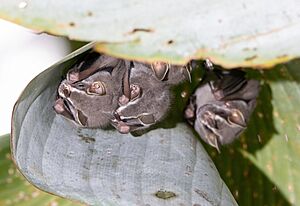Tent-making bat facts for kids
Quick facts for kids Tent-making bat |
|
|---|---|
 |
|
| Conservation status | |
| Scientific classification | |
| Genus: |
Uroderma
|
| Species: |
bilobatum
|
 |
|
The tent-making bat (Uroderma bilobatum) is a special type of bat. It lives in the warm, wet forests of Central and South America. This bat is about medium-sized. It has gray fur with a light white stripe down its back. Its face has a unique fleshy noseleaf and four white stripes.
These bats mostly eat fruit. But they also munch on insects, flower parts, pollen, and nectar. They are called "tent-making bats" because they build shelters. They make these "tents" from big, fan-shaped leaves. These leaf tents keep them safe from heavy tropical rains. Many bats can share one tent roost. This bat is very common where it lives. So, it is not considered endangered.
Contents
About Tent-Making Bats
The tent-making bat, Uroderma bilobatum, belongs to the Phyllostomidae family. This family is also known as the American leaf-nosed bats. It has 49 different groups of bats. These bats eat many different things. Some eat meat, some eat fruit, and others eat blood or nectar and pollen.
Leaf-nosed bats have a special nose. It looks like a leaf-shaped part sticking up from their upper lip. These bats use their noses to send out sounds. This helps them find things using echolocation. The noseleaf might help direct these sounds. They make calls at very low sounds. So, regular bat detectors often cannot hear them. This is why they are sometimes called "whispering bats."
Tailless Bats
Inside the Phyllostomidae family is a group called Stenodermatinae. These bats are sometimes called tailless bats. There are 17 groups of these bats in Central America. They have wide shoulders and faces. Their tail membranes are narrow. Their tails are either very small or missing. The leaf-like part on their nose has two folds. The bottom part is at least partly free.
The shape of their faces helps them eat fruit. They pick fruit with their mouths. Then they carry it to a safe spot to eat at night. Because of this, they help spread seeds for many plants.
Uroderma Bat Features
Bats in the Uroderma group have a pale white stripe. This stripe runs down their back. They also have two pairs of white stripes on their face. Their tail membrane is shaped like a "U." It has no hair along its edge. This group includes two species:
- Uroderma bilobatum Peters, 1866
- Uroderma magnirostrum Davis, 1968
Uroderma bilobatum has six types, called subspecies:
- U.b. bilobatum Peters
- U.b. trinitatum Davis
- U.b. thomasi Andersen
- U.b. convexum Lyon
- U.b. molaris Davis
- U.b. davisi Baker and McDaniel
What's in a Name?
The name Uroderma comes from ancient Greek words. Uro means "tail" and derma means "skin." So, it means "tail of skin." This describes their tail membrane. It is made only of skin. It does not have tail bones.
The species name bilobatum comes from Latin. Bi means "two" and lobat means "lobed." This refers to their first upper teeth. These teeth have two lobes or parts.
How They Look
The tent-making bat, Uroderma bilobatum, is a medium-sized bat. It weighs between 13 and 20 grams. Its body is about 59–69 millimeters long. Female bats are usually a bit bigger than males.
Their fur color can be dark gray to grayish-brown. Their belly is a bit lighter than their back. Each hair on their body has two colors. It is lighter at the bottom than at the top. A thin white stripe goes down the middle of their back. It runs from behind their head to their bottom.
Their face has two clear pairs of white stripes. One pair goes over their head, between and behind their ears. The other pair is just below their eyes. This "facemask" might help them hide. It makes their eyes less easy for predators to see. Their brown noseleaf and ears have yellow or white edges.
They have a U-shaped tail membrane. It is almost hairless. It measures 14–16 millimeters long. If you look at their skull from above, you will see a dip. This dip is between their forehead bone and their snout. They have 32 teeth in total.

Where They Live
These bats live in Central America. You can find them from Oaxaca and Veracruz, Mexico. Their range goes all the way to Peru, Bolivia, and southeastern Brazil. They also live on the island of Trinidad. Most of these bats are found in low areas. This means below 600 meters high. But some have been seen as high as 1500 meters above sea level.
Home and Food
Uroderma bilobatum lives in forests. These can be evergreen or deciduous forests. They also live in forests that are growing back. And they like fruit groves. They mainly eat fruit. They have been seen carrying small, unripe figs in their mouths. They also eat the outer part of small palm fruits. Sometimes they eat common guavas. They may also eat insects, flower parts, nectar, or pollen.
Body Functions
When U. bilobatum flies, its heart beats very fast. It beats about 900 times per minute. But they usually fly for only 30 minutes each day. When they rest at night, their heart rate slows down. It averages 490 beats per minute. During the day, it slows even more to about 375 beats per minute.
Their daytime heart rate sometimes drops even lower. This happens two to three times an hour. It lasts for 5 to 7 minutes each time. Their heart rate can go down to 200–250 beats per minute. This helps them save energy. Saving energy is very important for them to survive. Without food, their body fat would be used up in just 24 hours.
Reproduction and Life Cycle
Female tent-making bats can have babies twice a year. In Panama, pregnant females have been seen in February and June. In Costa Rica, pregnant females move into coconut groves in July. This is when the wet season begins. They all tend to give birth around the same time.
Each mother bat has only one baby at a time. The baby is born after about 4–5 months. Nursing mothers form groups of 20–40 bats. They all stay in one tent roost. Living in groups might help keep the babies and mothers warm.
They do not carry their babies when they fly out to find food at night. But it seems they might move their babies to safer roosts first. Then they go out to forage. The baby bats can live on their own after one month.
How They Make Tents
As their name suggests, Uroderma bilobatum has a special way of resting. They bite through the main vein of a large leaf. This makes the leaf fold in half. It forms a shelter shaped like an upside-down "V." This "tent" protects them from the sun, wind, and rain.
Eventually, the leaf dries up and falls off the plant. Then they have to build a new tent. This can take them several nights to finish. One tent can be used for up to 60 days. U. bilobatum likes large, single leaves. They prefer leaves from banana trees. They also like palm leaves that are shaped like feathers or hands.
They can roost in groups of 2 to 59 bats. They are easily scared from their tents during the day. They usually choose tall trees. But they do not pick the very tallest trees in the area. Taller trees might protect them more from predators. But trees that are too tall could expose them to stronger winds. They also prefer younger leaves. These leaves are usually further from the ground.
Bats that roost in leaves tend to move around more. This is different from bats that live in caves. Some people think this helps them find food all year. The tents might also protect them from predators. These predators often look for bats in caves or hollow trees. However, making new tents every few months takes a lot of energy. Also, these tents do not protect them as well from bad weather.
Bats and People
The tent-making bat, Uroderma bilobatum, is very common. It lives in many places. It can handle some forest clearings made by people. But if too many lowland tropical forests are lost, it could harm their survival. For now, its conservation status is listed as "Least Concern." This means it is not in danger of disappearing.


